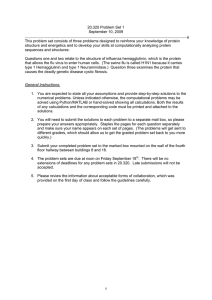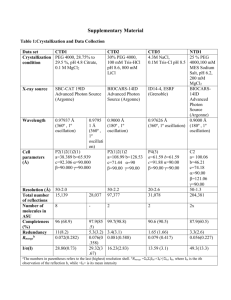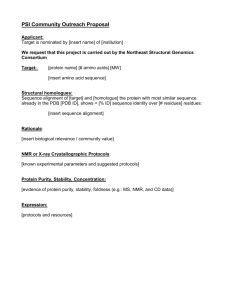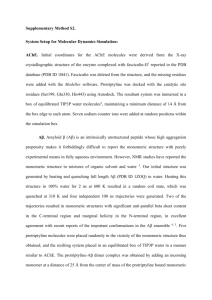Document 13355302
advertisement
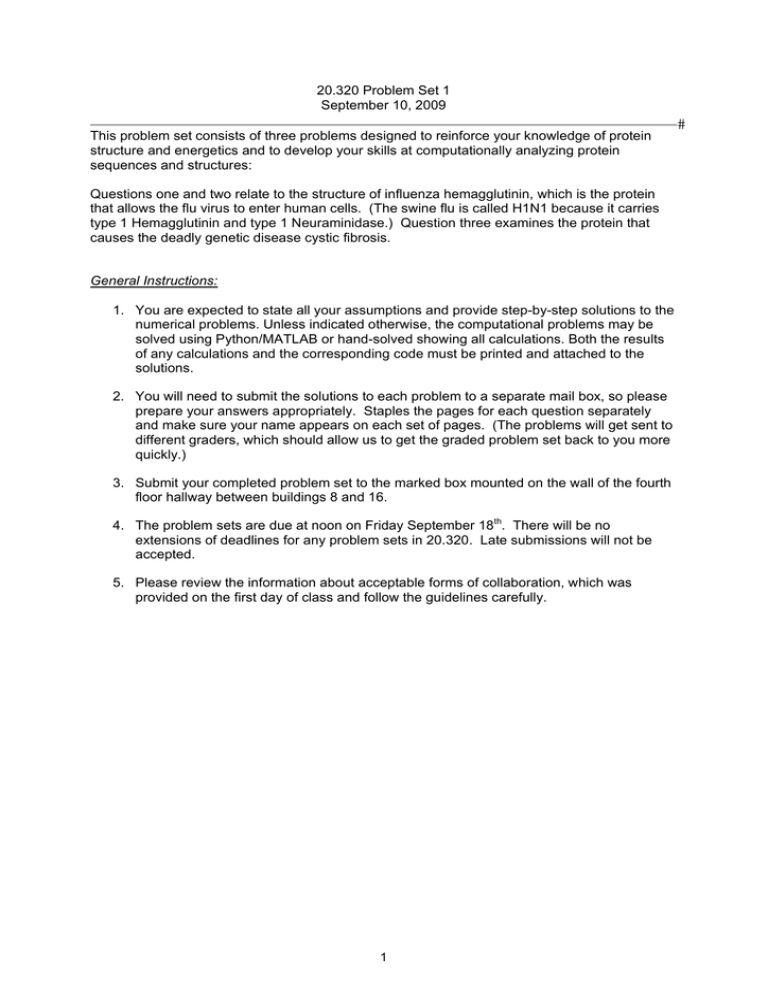
20.320 Problem Set 1
September 10, 2009
This problem set consists of three problems designed to reinforce your knowledge of protein
structure and energetics and to develop your skills at computationally analyzing protein
sequences and structures:
Questions one and two relate to the structure of influenza hemagglutinin, which is the protein
that allows the flu virus to enter human cells. (The swine flu is called H1N1 because it carries
type 1 Hemagglutinin and type 1 Neuraminidase.) Question three examines the protein that
causes the deadly genetic disease cystic fibrosis.
General Instructions:
1. You are expected to state all your assumptions and provide step-by-step solutions to the
numerical problems. Unless indicated otherwise, the computational problems may be
solved using Python/MATLAB or hand-solved showing all calculations. Both the results
of any calculations and the corresponding code must be printed and attached to the
solutions.
2. You will need to submit the solutions to each problem to a separate mail box, so please
prepare your answers appropriately. Staples the pages for each question separately
and make sure your name appears on each set of pages. (The problems will get sent to
different graders, which should allow us to get the graded problem set back to you more
quickly.)
3. Submit your completed problem set to the marked box mounted on the wall of the fourth
floor hallway between buildings 8 and 16.
4. The problem sets are due at noon on Friday September 18th. There will be no
extensions of deadlines for any problem sets in 20.320. Late submissions will not be
accepted.
5. Please review the information about acceptable forms of collaboration, which was
provided on the first day of class and follow the guidelines carefully.
1
#
20.320 Problem Set 1
Question 1
Hemagglutinins are a general class of factors that increase the affinity of red blood cells for
each other, causing clumps to form (the clumping of red blood cells is referred to as
hemagglutination). Although some hemagglutinins are expressed under normal conditions (for
instance, blood group antigens and the Rh factor), many pathogens express hemagglutinins
and hemagglutinin-like proteins to help them adhere to and invade host cells more effectively.
For example, the influenza viruses express hemagglutinin glycoproteins on their surfaces that
play a key role in the initial binding between virus and host cell.
Influenza hemagglutinin is particularly interesting because it exploits several features of the
cell’s endocytic pathway to protect the virus from degradation and to facilitate its release into the
cytoplasm. Once the virus attaches to the exterior of the cell it is internalized in a membranebound compartment called an endosome, which fuses with a lysosome to begin digesting what
the cell internalized. Key to this digestive process is the acidification of the endosome, since the
enzymes involved in digestion are only active when the pH is substantially lower than in the
cytoplasm. The influenza virus is able to exploit this acidification process using hemagglutinin.
The hemagglutinins on the viral surface undergo a pH-dependent conformational change,
exposing a hydrophobic pocket that can insert into the membrane of the endosome and fuse the
endosomal and viral membranes together. This allows the virus to escape degradation and
transit into the cytoplasm.
Structural data for both native HA (http://www.rcsb.org/pdb/cgi/explore.cgi?pdbId=3EYJ) and
HA at endosomal pH(http://www.rcsb.org/pdb/cgi/explore.cgi?pdbId=1HTM) can be obtained
from the Protein Data Bank (PDB).
a) Write a Python program to parse the PDB files and extract the phi and psi angles for the
HA2 chain (chain ‘B’ in the PDB files) of Hemagglutinin in its native state and at
endosomal pH. Use this to create a Ramachandran plot for both structures. (Note:
Since chain ‘B’ in PDB file 1HTM only contains residues 40-153 of chain ‘B’ in PDB file
3EYJ, only consider those residues.) For this problem, use the Biopython package.
Biopython is set of tools for biological computation written in Python and is free to
download here: http://biopython.org/wiki/Download Source code for the PDB package
can be found here: http://www.biopython.org/DIST/docs/api/Bio.PDB-module.html
Use the following code segment as a model for parsing a PDB file:
for model in Bio.PDB.PDBParser().get_structure("HA_Native", "3EYJ.pdb") :
polypeptides = Bio.PDB.PPBuilder().build_peptides(model["B"])
for poly_index, poly in enumerate(polypeptides) :
The following command is used to print the phi and psi angles of a polypeptide:
poly.get_phi_psi_list()
2
#
20.320 Problem Set 1
Question 1
#
# Problem Set 1 Question 1 # August 31, 2009 import
import
import
import
Bio.PDB math numpy as np pylab
# Part A: Create Ramachandran plot for Native and Endosomal HA # Parse PDB file for Native HA, extract angles, save them to array "native"
native = [[0,0]] native_range = range(39, 153)
for model in Bio.PDB.PDBParser().get_structure("HA_Native", "3EYJ.pdb") :
polypeptides = Bio.PDB.PPBuilder().build_peptides(model["B"])
for poly_index, poly in enumerate(polypeptides) : phi_psi = np.float_(poly.get_phi_psi_list())
phi_psi_deg = phi_psi * 180 / math.pi for res_index in native_range : native = np.append(native, [phi_psi_deg[res_index,:]], axis=0)
# Parse PDB file for Endosomal HA, extract angles, save them to array "endo"
endo = [[0,0]] endo_range = range(0, 114) for model in Bio.PDB.PDBParser().get_structure("HA_Endo", "1HTM.pdb") :
polypeptides = Bio.PDB.PPBuilder().build_peptides(model["B"])
for poly_index, poly in enumerate(polypeptides) : phi_psi = np.float_(poly.get_phi_psi_list())
phi_psi_deg = phi_psi * 180 / math.pi for res_index in endo_range : endo = np.append(endo, [phi_psi_deg[res_index,:]], axis=0)
# Create Ramachandran plots for each conformation pylab.figure(1) pylab.scatter(native[:,0], native[:,1], c='b', marker='o')
pylab.xlabel('Phi angle')
pylab.ylabel('Psi angle')
pylab.title('Ramachandran Plot for Native HA')
pylab.figure(2) pylab.scatter(endo[:,0], endo[:,1], c='b', marker='o')
pylab.xlabel('Phi angle')
pylab.ylabel('Psi angle')
pylab.title('Ramachandran Plot for Endosomal HA') # Part C: Create scatter plots for Phi/Psi angles by residue indices = range(0, 115)
pylab.figure(3) pylab.scatter(indices, native[:,0], c='b', marker='o')
pylab.scatter(indices, endo[:,0], c='r', marker='o')
pylab.xlabel('Residue Position in Common Sequence') pylab.ylabel('Phi Angle')
pylab.title('Phi Angles')
pylab.figure(4) pylab.scatter(indices, native[:,1], c='b', marker='o')
pylab.scatter(indices, endo[:,1], c='r', marker='o')
pylab.xlabel('Residue Position in Common Sequence') pylab.ylabel('Psi Angle')
pylab.title('Psi Angles')
# Part D: Helical in one conformation but not the other 3
20.320 Problem Set 1
Question 1
#
# Fill arrays with indices of helical residues
native_helices = [] for index in indices : if native[index, 0] < -57 : if native[index, 0] > -71 : if native[index, 1] > -48 : if native[index, 1] < -34 : native_helices.append(index+39)
endosome_helices = []
for index in indices :
if endo[index, 0] < -57 :
if endo[index, 0] > -71 :
if endo[index, 1] > -48 :
if endo[index, 1] < -34 :
endosome_helices.append(index+39)
# Search for indices appearing only once
unique = 0
for index in native_helices :
if endosome_helices.count(index) == 0 :
unique += 1
for index in endosome_helices :
if native_helices.count(index) == 0 :
unique += 1
print "Helical Residues, Native: ", native_helices
print "Helical Residues, Endosomal: ", endosome_helices
print "Unique helical residues: %i" % unique
pylab.show()
.
4
20.320 Problem Set 1
Question 1
#
b) What do the Ramachandran plots tell you about the secondary structure of HA in these
two conformations?
The Ramachandran plots indicate that both conformations have many residues in alphahelical conformations, with more endosomal hemagglutinin having more helical residues and
fewer in beta sheet conformations.
c) Plot phi angles vs. residue number for the two conformations on the same plot. (Each
position on the x-axis should have two data points, representing the phi angle of that
residue in the two structures). Make a similar plot for psi angles.
5
20.320 Problem Set 1 Question 1
#
Blue dots correspond to residues in native hemagglutinin, while red dots correspond to
hemagglutinin residues at endosomal pH.
6
20.320 Problem Set 1 Question 1
d) Based on the phi/psi angles, determine the number of residues that are alpha helical in
one structure but not in the other. Define a helical residue as one where phi is between
-57 and -71˚, and psi is between -34 and -48˚.
#
Based on the given criteria, the program calculates the following residues as helical for
hemagglutinin at native and endosomal pH:
Helical Residues, Native: [40, 41, 42, 43, 47, 48, 49, 53, 77, 78, 81, 82, 83, 84, 85, 86, 88, 89, 90, 91, 93, 96, 97, 99, 106, 107, 110, 111, 112, 114, 115, 116, 117, 120, 122, 125, 147, 148] Helical Residues, Endosomal: [41, 44, 46, 48, 60, 61, 63, 65, 68, 69, 71,
81, 82, 88, 91, 96, 97, 99, 119, 126, 127, 148] Unique helical residues: 40
7
20.320 Problem Set 1
Question 2
Key to the function of influenza hemagglutinin is its pH-dependant conformational change in the
endosome, fusing the viral membrane with the endosomal membrane and allowing release of
the virus into the cytoplasm.
#
a) Of the principal forces responsible for maintaining the tertiary structure of a protein,
which would be most strongly affected by the acidification of the surrounding
environment?
Salt bridges (also charge-charge interactions or ionic bonds) would be most strongly affected by
pH. Acidifying the environment could protonate amino acids with pKa values below physiological
pH, either conferring a positive charge (e.g. histidine) or neutralizing a negative charge (e.g.
glutamate, aspartate). This would affect which salt bridges could form and which protein
conformation would be most energetically favorable. Of the other forces responsible for
maintaining tertiary structure, neutralizing charge would not significantly alter the hydrophobicity
of a protein nor would it adversely affect hydrogen bonding.
Structural studies have shown that several histidine residues play a key role in mediating this
pH-dependent conformational change of influenza hemagglutinin.
b) What property of histidine makes it especially suited to this role? Which other amino
acid residues could potentially serve the same function? Be sure to justify your
choices.
Histidine is unique in that its side-chain pKa value is 6.1, which is close to physiological pH. At
physiological pH (7.4), histidine is singly protonated, uncharged, and therefore incapable of
forming salt bridges. Upon the acidification of the endosome, histidine becomes doubly
protonated with a net positive charge. Presuming the pH of the endosome remained above the
pKa values of glutamate and/or aspartate, the doubly protonated histidine could then interact
with either of these residues.
Glutamate and aspartate could serve a similar function, but the endosome would have to be
made much more acidic. Both have side-chain pKa values close to 4.0; therefore at higher pH
values they can form salt bridges with positively charged residues.
One way to determine which residues are vital to the structure and function of a protein is to
align the sequences of many variants of the protein and look for conserved residues (those that
are present in the same position in each protein variant). We can do this by comparing the
hemagglutinins across various serotypes of human influenza A. On the Course website, you will find
a document containing the amino acid sequences of several influenza hemagglutinins (H1, H2,
H3, H5, H7, and H9).
c) Use CLUSTALW to find histidine residues that are conserved across all six
sequences. Attach the CLUSTALW alignment, highlighting the residues you find.
CLUSTALW is available on Athena clusters, or you can find a web client here:
http://www.ebi.ac.uk/Tools/clustalw2/index.html
8
20.320 Problem Set 1 Question 2
#
gi|63054902|gb|AAY28987|
gi|251757610|gb|ACT15357|
gi|256383631|gb|ACU78205|
gi|81174796|gb|ABB58945|
gi|254564370|gb|ACT67810|
gi|115279133|gb|ABI85000|
----MAIIYLILLFTAVRG-------DQICIGYHANNSTEKVDTILERNV
---MEKIVLLLAIVSLVKS-------DQICIGYHANNSTEQVDTIMERNV
--MKAILVVLLYTFATANA-------DTLCIGYHANNSTDTVDTVLEKNV
-----------LMVTAINA-------DKICIGYQSTNSTETVDTLTKTNV
MKTIIALSYILCLVFAQKLPGNDNSTATLCLGHHAVPNGTIVKTITNDQI
MNTQI-LAFIACMLIGTKG-------DKICLGHHAVANGTKVNTLTERGI
.
.
:*:*::: .
*.*: : :
39
40
41
32
50
42
gi|63054902|gb|AAY28987|
gi|251757610|gb|ACT15357|
gi|256383631|gb|ACU78205|
gi|81174796|gb|ABB58945|
gi|254564370|gb|ACT67810|
gi|115279133|gb|ABI85000|
TVTHAKDILEKTHNGKLCKLNGIPPLELGDCSIAGWLLGNPECDRLLSVP
TVTHAQDILEKTHNGKLCNLDGVKPLILRDCSVAGWLLGNPMCDEFLNVP
TVTHSVNLLEDKHNGKLCKLRGVAPLHLGKCNIAGWILGNPECESLSTAS
PVTQAKELLHTEHNGMLCATNLGHPLILDTCTIEGLIYGNPSCDLLLGGR
EVTNATELVQSSSTGEICDS-PHQILDGKNCTLIDALLGDPQCDGFQN-K
EVVNATETVETVNIKKICTQ-GKRPTDLGQCGLLGTLIGPPQCDQFLE-F
*.:: : :.
:*
* : . : * * *: :
89
90
91
82
98
90
gi|63054902|gb|AAY28987|
gi|251757610|gb|ACT15357|
gi|256383631|gb|ACU78205|
gi|81174796|gb|ABB58945|
gi|254564370|gb|ACT67810|
gi|115279133|gb|ABI85000|
EWSYIMEKENPRDGLCYPGSFNDYEELKHLLSSVKHFEKVKILPKDR-WT
EWSYIVEKINPANDLCYPGNFNDYEELKHLLSRINHFEKIQIIPKNS-WS
SWSYIVETSSSDNGTCYPGDFIDYEELREQLSSVSSFERFEIFPKTSSWP
EWSYIVERPSAVNGMCYPGNVENLEELRLLFSSASSYQRVQIFPDTI-WN
KWDLFVER-SKAYSNCYPYDVPDYASLRSLVASSGTLE---FNNESFNWT
DANLIIER-REGTDVCYPGKFTNEESLRQILRGSGGID---KESMGFTYS
. . ::*
. *** .. : .*: .
:
:
138
139
141
131
144
136
gi|63054902|gb|AAY28987|
gi|251757610|gb|ACT15357|
gi|256383631|gb|ACU78205|
gi|81174796|gb|ABB58945|
gi|254564370|gb|ACT67810|
gi|115279133|gb|ABI85000|
QHTTT-GGSRACAVSGNPSFFRNMVWLT--KKGSNYPVAQGSYNNTSGEQ
DHEAS-GVSSACPYQGRSSFFRNVVWLT--QKDNAYPTIKRSYNNTNQED
NHDSNKGVTAACPHAGAKSFYKNLIWLV--KKGNSYPKLSKSYINDKGKE
VTYSG--TSSACSN----SFYRSMRWLT--QKDNTYPVQDAQYTNNRGKS
GVTQN-GTSSACIRRSKNSFFSRLNWLT--HLNFKYPALNVTMPNNEQFD
GIRTN-GATSACRR-SGSSFYAEMKWLLSNSDNAAFPQMTKSYRNPRNKP
: **
**: : **
. :*
* 185
186
189
173
191
184
gi|63054902|gb|AAY28987|
gi|251757610|gb|ACT15357|
gi|256383631|gb|ACU78205|
gi|81174796|gb|ABB58945|
gi|254564370|gb|ACT67810|
gi|115279133|gb|ABI85000|
MLIIWGVHHPNDETEQRTLYQNVGTYVSVGTSTLNKRSTPEIATRPKVNG
LLVLWGIHHPNDAAEQTRLYQNPTTYISVGTSTLNQRLIPKIATRSKVNG
VLVLWGIHHPSTSADQQSLYQNADAYVFVGSSRYSKKFKPEIAIRPKVRD
ILFMWGINHPPTDTVQTNLYTRTDTTTSVTTEDINRAFKPVIGPRPLVNG
KLYIWGVHHPGTDKDQIFXXAQASGRITVSTKRSQQTVIPNIGSRPRVRN
ALIIWGVHHSGSATEQTKLYGSGNKLITVGSSKYQQSFTPSPGARPQVNG
* :**::*.
*
* :. .:
* . *. *..
235
236
239
223
241
234
gi|63054902|gb|AAY28987|
gi|251757610|gb|ACT15357|
gi|256383631|gb|ACU78205|
gi|81174796|gb|ABB58945|
gi|254564370|gb|ACT67810|
gi|115279133|gb|ABI85000|
QGGRMEFSWTLLDMWDTINFESTGNLIAPEYGFKISKRGSSGIMKTEGTL
QSGRMEFFWTILKSNDAINFESNGNFIAPENAYKIVKKGDSTIMKSELEY
QEGRMNYYWTLVEPGDKITFEATGNLVVPRYAFAMERNSGSGIIISDTPV
LQGRIDYYWSVLKPGQTLRVRSNGNLIAPWYGHILSGESHGRILKSDLNS
IPSRISIYWTIVKPGDILLINSTGNLIAPRGYFKIRS-GKSSIMRSDAPI
QSGRIDFHWLLLDPNDTVTFTFNGAFIAPDRASFFR--GESLGVQSDVPL
.*:. * ::. : : . .* ::.*
:
. . : ::
285
286
289
273
290
282
gi|63054902|gb|AAY28987|
gi|251757610|gb|ACT15357|
gi|256383631|gb|ACU78205|
gi|81174796|gb|ABB58945|
gi|254564370|gb|ACT67810|
gi|115279133|gb|ABI85000|
E-NCETKCQTPLGAINTTLPFHNVHPLTIGECPKYVKSEKLVLATGLRNV
G-NCNTKCQTPIGAINSSMPFHNIHPLTIGECPKYVKSNRLVLATGLRNS
H-DCNTTCQTPKGAINTSLPFQNIHPITIGKCPKYVKSTKLRLATGLRNV
G-NCVVQCQTERGGLNTTLPFHNVSKYAFGNCPKYVGVKSLKLAVGMRNV
G-KCNSECITPNGSIPNDKPFQNVNRITYGACPRYVKQNTLKLATGMRNV
DSGCEGDCFHSGGTIVSSLPFQNINPRTVGKCPRYVKQTSLLLATGMRNV
*
*
* : . **:*:
: * **:**
* **.*:**
334
335
338
322
339
332
gi|63054902|gb|AAY28987|
gi|251757610|gb|ACT15357|
gi|256383631|gb|ACU78205|
gi|81174796|gb|ABB58945|
gi|254564370|gb|ACT67810|
gi|115279133|gb|ABI85000|
PQIE--------SRGLFGAIAGFIEGGWQGMVDGWYGYHHSNDQGSGYAA
PQGER----RRKKRGLFGAIAGFIEGGWQGMVDGWYGYHHSNEQGSGYAA
PSIQ--------SRGLFGAIAGFIEGGWTGMVDGWYGYHHQNEQGSGYAA
PARS--------SRGLFGAIAGFIEGGWPGLVAGWYGFQHSNDQGVGMAA
PE--------KQTRGIFGAIAGFIENGWEGMVDGWYGFRHQNSEGRGQAA
PENPKQAYQKRMTRGLFGAIAGFIENGWEGLIDGWYGFRHQNAQGEGTAA
*
.**:*********.** *:: ****::*.* :* * **
376
381
380
364
381
382
9
20.320 Problem Set 1
Question 2
gi|63054902|gb|AAY28987|
gi|251757610|gb|ACT15357|
gi|256383631|gb|ACU78205|
gi|81174796|gb|ABB58945|
gi|254564370|gb|ACT67810|
gi|115279133|gb|ABI85000|
DKESTQKAFDGITNKVNSVIEKMNTQFEAVGKEFSNLERRLENLNKKMED
DKESTQKAIDGVTNKVNSIIDKMNTQFEAVGREFNNLERRIENLNKKMED
DLKSTQNAIDEITNKVNSVIEKMNTQFTAVGKEFNHLEKRIENLNKKVDD
DRDSTQKAIDKITSKVNNIVDKMNKQYEIIDHEFSEIETRLNMINNKIDD
DLKSTQAAIDQINGKLNRLIGKTNEKFHQIEKEFSEVEGRIQDLEKYVED
DYKSTQSAIDQITGKLNRLIDKTNQQFELIDNEFSEIEQQIGNVINWTRD
* .*** *:* :..*:* :: * * :: : .**..:* :: : :
*
426
431
430
414
431
432
gi|63054902|gb|AAY28987|
gi|251757610|gb|ACT15357|
gi|256383631|gb|ACU78205|
gi|81174796|gb|ABB58945|
gi|254564370|gb|ACT67810|
gi|115279133|gb|ABI85000|
GFLDVWTYNAELLVLMENERTLDFHDSNVKNLYDKVRMQLRDNVKELGNG
GFLDVWTYNAELLVLMENERTLDFHDSNVKNLYDKVRLQLRDNAKELGNG
GFLDIWTYNAELLVLLENERTLDYHDSNVKNLYEKVRSQLKNNAKEIGNG
QIQDIWAYNAELLVLLENQKTLDEHDANVNNLYNKVKRALGSNAMEDGKG
TKIDLWSYNAELLVALENQHTIDLTDSEMNKLFEKTKKQLRENAEDMGNG
SMTEVWSYNAELLVAMENQHTIDLADSEMNKLYERVRKQLRENAEEDGTG
::*:******* :**::*:* *:::::*:::.: * .*. : *.*
476
481
480
464
481
482
gi|63054902|gb|AAY28987|
gi|251757610|gb|ACT15357|
gi|256383631|gb|ACU78205|
gi|81174796|gb|ABB58945|
gi|254564370|gb|ACT67810|
gi|115279133|gb|ABI85000|
CFEFYHKCDDECMNSVKNGTYDYPKYEEESKLNRNEIKGVKLSSMGVYQI
CFEFYHRCDNECMESVRNGTYDYPQYSEEARLKREEISGVKLESIGTYQI
CFEFYHKCDNTCMESVKNGTYDYPKYSEEAKLNREEIDGVKLESTRIYQI
CFELYHKCDDRCMETIRNGTYNRGKYKEESRLERQKIEGVKLESEGTYKI
CFKIYHKCDNACIGSIRNGTYDHDVYRDEALNNRFQIKGVELKS-GYKDW
CFEIFHKCDDQCMESIRNNTYDHTQYRTESLQNRIQIDPVKLSS-GYKDI
**:::*:**: *: :::*.**:
* *: :* :*. *:*.*
.
526
531
530
514
530
531
gi|63054902|gb|AAY28987|
gi|251757610|gb|ACT15357|
gi|256383631|gb|ACU78205|
gi|81174796|gb|ABB58945|
gi|254564370|gb|ACT67810|
gi|115279133|gb|ABI85000|
LAIYATVAGSLSLAIMMAGISFWMCSNGSLQCRICI
LSIYSTVASSLALAIMVAGLFLWMCSNGSLQCRICI
LAIYSTVASSLVLVVSLGAISFWMCSNGSLQCRICI
LTIYSTVASSL------------------------ILWISFAISCFLLCVALLGFIMWACQKGNIRCNICI
ILWFSFGASCFLLLAIAMGLVFICIKNGNMRCTICI
:
:
..:
562
567
566
525
566
567
CLUSTALW identifies 3 histidine residues (indicated in bold above) that are conserved across
all six hemagglutinin sequences.
d) Assuming the pH of the acidified endosome is 4.5, which types of residues would
you expect to see complexed with these key histidines? Based on your CLUSTALW
analysis, identify the other residues that are likely involved with this pH-dependant
transition.
If the pH of the acidified endosome is 4.5, a significant number of glutamate (E, pKa = 4.07)
residues will be negatively charged, while the majority of aspartate (D, pKa = 3.86) residues will
be negatively charged. These would form salt bridges with the positively charged histidine
residues and stabilize the conformation of hemagglutinin. If these residues are required for this
stabilization, they should be conserved as well. The CLUSTALW analysis indicates there are
several aspartate and glutamate residues that are conserved across all six sequences
(highlighted in green).
10
#
20.320 Problem Set 1
Question 2
#
e) Use Biopython to compute the distance between the alpha carbons of the conserved
histidine residues you identified in Part (c) and the other conserved residues you
identified in Part (d). Report the minimum distance you find for each conserved
histidine. Does any pair of residues seem especially close together? Some hints:
1. For this exercise, as with Question 1, only consider residues in the “B” chain
of hemagglutinin at endosomal pH. This sequence is posted on the Course website
in FASTA format.
2. It will help to repeat your CLUSTALW alignment from Part (c) with this new
sequence – this will help you find the residues you are looking for.
3. You can copy and paste the FASTA sequence directly into the list of
hemagglutinin sequences you analyzed in Part (c).
4. You should only be looking for residues that are conserved across all seven
sequences in your new alignment.
5. residue["CA"].coord returns the coordinates (x, y, z) of the alpha carbon of
residue
When we consider chain “B” of influenza hemagglutinin at endosomal pH, only the last histidine
in the sequence (H142) is absolutely conserved. We are therefore interested in the distances
between H142 and the absolutely conserved acidic residues in chain “B”, namely E57, E61,
D86, E97, E103, D109, D112, and D145.
The following code will calculate and print the distance between H142 and the specified
residues:
# Problem Set 1 Question 2 # August 31, 2009 import Bio.PDB import numpy
res_index = [17, 21, 46, 57, 63, 69, 72, 85]
for model in Bio.PDB.PDBParser().get_structure("HA_Endosomal", "1HTM.pdb") : polypeptides = Bio.PDB.PPBuilder().build_peptides(model["B"])
for poly_index, poly in enumerate(polypeptides) :
key_his = poly[102]
print "Distances from %s%i: (angstroms)" % (key_his.resname, key_his.id[1])
for index in res_index :
dist_vector = poly[index]["CA"].coord - key_his["CA"].coord
distance = numpy.sqrt(numpy.sum(dist_vector * dist_vector))
output = "%s%i %f" % (poly[index].resname, poly[index].id[1], distance) print output
This code produces the following output:
Distances from HIS142: (angstroms)
GLU57 44.210747 GLU61 37.950996 ASP86 5.515404 GLU97 17.523859 GLU103 27.225662
ASP109 30.871565
ASP112 32.381725
GLN125 14.174937
Based on this, His142 seems especially close to Asp86, potentially indicating a salt bridge
between these two residues.
11
20.320 Problem Set 1
Question 3
Cystic fibrosis (CF) is a genetic disorder caused by a mutation(s) in the cystic fibrosis
transmembrane conductance regulator (CTFR) gene. CTFR, the protein product, is a traffic
ATPase that transports chloride ions across epithelial cell membranes. Mutations lead to
improper folding of CTFR and prevent proper chloride ion transport across these cell
membranes. The ∆F508 mutation, aka the deletion of the phenylalanine (F) at position 508, is
the most common mutation associated with cystic fibrosis.
a) Explain why the deletion of the phenylalanine (F) at position 508 might lead to misfolding
(discuss the amino acid & its impact on structure).
The deletion of phenylalanine at position 508 leading to a folding defect can be explained by two
possibilities: 1. the loss of the spacing effect of the peptide backbone, or 2. the loss of the
phenylalanine side chain. Phenylalanine is an aromatic amino acid and therefore contributes to
a hydrophobic region of the nucleotide binding domain. Since the phenylalanine side chain is
partially surface-exposed, deletion of this amino acid can introduce local structural changes to
the amino acid residues surrounding F508. Deletion of the peptide backbone would bring
together two amino acid side chains that originally were separated. This would change the
conformational space of the original surface and could lead to misfolding. (Experiments have
shown that the peptide backbone is critical for the folding efficiency. Side chain mutations have
little effect in proper folding.) (Thibodeau et al. Nat Struct Mol Biol 12 2004 p10-16)
The ∆F508 mutation along with several other known mutations that cause CF, occur in a region
of the CTFR known as a nucleotide binding domain (NBD1). In an experiment, (Qu & Thomas
JBC 271:13 1996 p. 7261-7264) NBD1 and NBD1 with the ∆F508 mutation (NBD1∆F) were
tested for folding yield at different temperatures.
b) Calculate the ∆Gfold (kcal/mol) at 37°C and 25°C of NBD1 and NBD1∆ using the
following data: From the paper, we know that “at 2 µM final NBD1 concentration and
37°C, 63% of the wild type polypeptide folds into the soluble conformation, while only
38% of the F508 assumes the folded conformation. At 18 µM final polypeptide
concentration and 25 °C, 29% of the wild type domain reaches the native state in
contrast to 19% of the F508 mutant.” Are these values reasonable? Explain.
( U)
From lecture, we know that: ΔGfold = −RT ln K fold = −RT ln F
Therefore, at 37˚C:
WT: ΔGfold = −(1.987 cal mol−K)(310 K )ln 63%
(
∆F508: ΔGfold
)
= −328 cal mol = −0.33 kcal mol
37%
= −(1.987 cal mol−K)(310 K )ln 38% 62% = 302 cal mol = 0.30 kcal
mol
(
And at 25˚C:
WT: ΔGfold = −(1.987 cal mol−K )(298 K )ln 29%
(
∆F508: ΔGfold
)
)
= 530 cal mol = 0.53 kcal mol
71%
= −(1.987 cal mol−K)(298 K )ln 19% 81% = 858 cal mol = 0.86 kcal
mol
(
12
)
#
20.320 Problem Set 1
Question 3
#
This same group determined the free energy change of denaturation GD of wild-type NBD1
along with various other mutants from known CF cases at 37°C in a separate publication (Qu et
al, JBC 272:25 1997 p 15739-15744), using somewhat different experimental conditions from
the 1996 paper.
Protein
NBD1
NBD1∆F
NBD1-R553M
NBD1∆F-R553M
NBD1-S549R
NBD1-G551D
∆GD,0 (kJ/mol)
15.5
14.4
16.6
14.1
16.7
16.6
∆∆GD,0 (kJ/mol)
-1.1
1.1
-1.4
1.2
1.1
c) Given the values of the ∆Gs calculate the Kfold (ratio of folded to unfolded) of wild-type
NBD1 and all of the mutants. (∆Gfold = -∆GD)
⎛ ΔGfold ⎞
⎛ ΔG ⎞
⎟ = exp⎜ D ⎟
⎝ RT ⎠
⎝ RT ⎠
Rearranging the above equations: K fold, NBD1 = exp⎜ −
Therefore,
⎛
⎞
15.5 kJ mol
K fold, NBD1 = exp⎜
⎟ = 409
kJ
⎝ 0.0083 mol K × 310K ⎠
Similarly, the following Kfold values can be calculated:
∆GD
(kJ/mol)
15.5
14.4
16.6
14.1
16.7
16.6
Mutant
NBD1
NBD1∆F
NBD1-R553M
NBD1∆F-R553M
NBD1-S549R
NBD1-G551D
Kfold
(Unitless)
409
267
627
238
651
627
d) Is the ∆Gfold for the wild type in Part (c) the same as your answer to Part (b)? Explain.
No, the ∆Gfold values are quite different between experiments. The wild-type protein has a ∆Gfold
of < 1 kcal/mol in the first set of experiments, but roughly 3 kcal/mol in the second set (recall
that 1 kcal = 4.184 kJ). This could be due to differences between conditions under which the
experiments were performed. Salt concentrations and buffer compositions could affect the
reported ∆G values, as could crowding effects from differing concentrations of the protein.
13
MIT OpenCourseWare
http://ocw.mit.edu
20.320 Analysis of Biomolecular and Cellular Systems
Fall 2012
For information about citing these materials or our Terms of Use, visit: http://ocw.mit.edu/terms.
